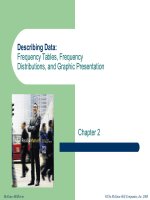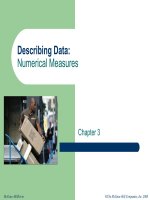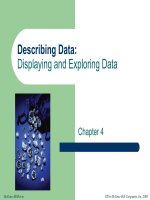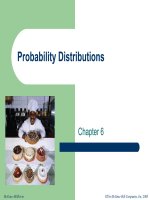Business lecture CHAPTER 5a
Bạn đang xem bản rút gọn của tài liệu. Xem và tải ngay bản đầy đủ của tài liệu tại đây (77.5 KB, 28 trang )
Chapter 5
International
Trade Theory
5-1
Introduction
International trade theory
explains why it is beneficial for countries to engage in international trade
helps countries formulate their economic policy
explains the pattern of international trade in the world economy
5-2
An Overview of Trade Theory
Question: What is free trade?
Answer:
Free trade refers to a situation where a government does not attempt to influence through quotas
or duties what its citizens can buy from another country or what they can produce and sell to
another country
5-3
An Overview of Trade Theory
Question: How has international trade theory evolved?
Answer:
Mercantilism (16th and 17th centuries) encouraged exports and discouraged imports
Adam Smith (1776) promoted unrestricted free trade
David Ricardo (19th century) built on Smith ideas
Eli Heckscher and Bertil Ohlin (20th century ) refined Ricardo’s work
5-4
The Benefits of Trade
Question: Why is it beneficial for countries to engage in free trade?
Answer:
International trade allows a country to specialize in the manufacture and export of products that
can be produced most efficiently in that country, and import products that can be produced more
efficiently in other countries
it is beneficial for a country to engage in international trade even for products it is able to
produce for itself
5-5
The Pattern of International Trade
International trade theory helps explain trade patterns
Some patterns of trade are fairly easy to explain - it is obvious why Saudi Arabia exports oil,
Ghana exports cocoa, and Brazil exports coffee
But, why does Switzerland export chemicals, pharmaceuticals, watches, and jewelry?
Why
does Japan export automobiles, consumer electronics, and machine tools?
5-6
Trade Theory and Government Policy
While the theories all suggest that trade is beneficial, they lack agreement in their
recommendations for government policy
Mercantilism makes a case for government involvement in promoting exports and limiting
imports
Smith, Ricardo, and Heckscher-Ohlin promote unrestricted free trade
New trade theory and Porter justify limited and selective government intervention to support
the development of certain export-oriented industries
5-7
Mercantilism
Mercantilism (mid-16th century) - it is in a country’s best interest to maintain a trade surplus - to
export more than it imports
it advocated government intervention to achieve a surplus in the balance of trade
it viewed trade as a zero-sum game (one in which a gain by one country results in a loss by
another)
Mercantilism is problematic and not economically valid, yet many political views today have the
goal of boosting exports while limiting imports by seeking only selective liberalization of trade
5-8
Absolute Advantage
Smith (1776) - countries differ in their ability to produce goods efficiently
A country has an absolute advantage in the production of a product when it is more efficient than
any other country in producing it
According to Smith
trade is not a zero-sum game
countries should specialize in the production of goods for which they have an absolute
advantage and then trade these goods for the goods produced by other countries
5-9
Absolute Advantage
Assume that two countries, Ghana and South Korea, both have 200 units of resources that could
either be used to produce rice or cocoa
In Ghana, it takes 10 units of resources to produce one ton of cocoa and 20 units of
resources to produce one ton of rice
So, Ghana could produce 20 tons of cocoa and no rice, 10 tons of rice and no cocoa, or
some combination of rice and cocoa between the two extremes
5-10
Absolute Advantage
In South Korea it takes 40 units of resources to produce one ton of cocoa and 10 resources
to produce one ton of rice
So, South Korea could produce 5 tons of cocoa and no rice, 20 tons of rice and no cocoa, or
some combination in between
Ghana has an absolute advantage in the production of cocoa
South Korea has an absolute advantage in the production of rice
5-11
Absolute Advantage
Without trade
Ghana would produce 10 tons of cocoa and 5 tons of rice
South Korea would produce 10 tons of rice and 2.5 tons of cocoa
If each country specializes in the product in which it has an absolute advantage and trades for the
other product
Ghana would produce 20 tons of cocoa
South Korea would produce 20 tons of rice
5-12
Absolute Advantage
Suppose
Ghana could trade 6 tons of cocoa to South Korea for 6 tons of rice
After trade
Ghana would have 14 tons of cocoa left, and 6 tons of rice
South Korea would have 14 tons of rice left and 6 tons of cocoa
Both countries gained from trade
5-13
Comparative Advantage
Ricardo’s theory of comparative advantage - a country should specialize in the production of
those goods that it produces most efficiently and buy the goods that it produces less efficiently
from other countries
5-14
The Gains from Trade
The theory of comparative advantage - trade is a positive sum gain in which all gain
potential world production is greater with unrestricted free trade than it is with restricted trade
provides a strong rationale for encouraging free trade
5-15
Extensions of the Ricardian Model
The Link between Trade and Growth
Countries that adopt a more open stance toward international trade enjoy higher growth rates than
those that close their economies to trade
higher growth rates raise income levels and living standards
5-16
Heckscher-Ohlin Theory
Heckscher and Ohlin - comparative advantage arises from differences in national factor
endowments (the extent to which a country is endowed with resources such as land, labor, and
capital)
the more abundant a factor, the lower its cost
countries will export goods that make intensive use of those factors that are locally
abundant, and import goods that make intensive use of factors that are locally scarce
5-17
The Product Life Cycle Theory
Vernon (mid-1960s ) proposed the product life-cycle theory - as products mature both the location
of sales and the optimal production location will change affecting the flow and direction of trade
the wealth and size of the U.S. market gave a strong incentive to U.S. firms to develop new
products
In the early stages of a product’s life cycle demand may grow in the U.S., but demand in other
advanced countries is limited to high-income groups
it is not worthwhile for firms in those countries to start producing the new product, but it does
necessitate some exports from the U.S. to those countries
5-19
The Product Life Cycle Theory
Over time, demand for the new product starts to grow in other advanced countries making it
worthwhile for foreign producers to begin producing for their home markets
U.S. firms might also set up production facilities in those advanced countries where demand
is growing limiting the exports from the U.S.
As the market in the U.S. and other advanced nations matures, the product becomes more
standardized, and price becomes the main competitive weapon
5-20
The Product Life Cycle Theory
Producers based in advanced countries where labor costs are lower than the United States might
now be able to export to the U.S.
If cost pressures become intense, developing countries begin to acquire a production advantage
over advanced countries
The United States switches from being an exporter of the product to an importer of the product as
production becomes more concentrated in lower-cost foreign locations
5-21
Evaluating The Product Life Cycle Theory
While the product life cycle theory accurately explains what has happened for products like
photocopiers and a number of other high technology products developed in the US in the 1960s
and 1970s, the increasing globalization and integration of the world economy has made this
theory less valid in today's world
today, many new products are initially introduced in Japan or Europe, or are introduced
simultaneously in the U.S., Japan, and Europe
production may also be dispersed to those locations where it is most favorable
5-23
New Trade Theory
New trade theory (1970s) suggests
Because of economies of scale (unit cost reductions associated with a large scale of output),
trade can increase the variety of goods available to consumers and decrease the average cost
of those goods
5-24
Increasing Product Variety and Reducing Costs
Without trade
a small nation may not be able to support the demand necessary for producers to realize
required economies of scale, and so certain products may not be produced
With trade
a nation may be able to specialize in producing a narrower range of products and then buy
the goods that it does not make from other countries
each nation then simultaneously increases the variety of goods available to its consumers
and lowers the costs of those goods
5-25
Economies of Scale and First Mover Advantages
Firms with first mover advantages (the economic and strategic advantages that accrue to many
entrants into an industry) will develop economies of scale and create barriers to entry for other
firms
5-26
Implications of New Trade Theory
New trade theory suggests
a country may predominate in the export of a good simply because it was lucky enough to
have one or more firms among the first to produce that good
5-27









